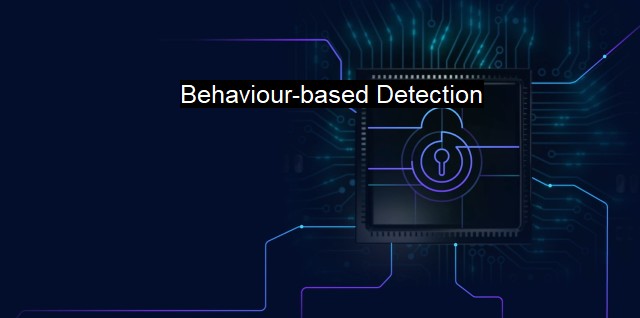What is Behaviour-based Detection?
Behavior-Based Detection: An Innovative Approach for Cybersecurity Threat Identification in the Age of Digital Interconnectedness
Behaviour-based detection is a intricate facet of cybersecurity that helps in identifying malicious activities on a system. It forms a core component of many anti-malware, antivirus, and other security software solutions. Behaviour-based detection operates on a different premise than traditional antivirus programs which primarily deploy signature-based detection.While signature-based detection scans system files for known threats by comparing them to a vast database containing definitions of identified malware, behaviour-based detection instead monitors the conduct or the actions of programs installed and operant within your computer. It does not look for definitions of known malware entities. Rather, it watches for suspicious activity or unusual behaviour. The deviation from standard routines is used to detect new or previously unencountered forms of malware or malicious threats.
Some known malware may alter their code to bypass signature-based detection, making them more potent, harder to detect, and unfortunately, more widespread. That's when behaviour-based detection appears as a knight in shining cybersecurity armour. By constantly monitoring for erratic activity, behaviour-based detection can identify threats which sleep in your system's DNA undeterred, masked by code-morphing mechanisms.
Behaviour-based detection encompasses activities such as tracking changes made to a system’s file, logging the reading, and copying of data files, scrutinizing the operation of physical devices, as well as monitoring the network for any abnormal traffic. For instance, if a program scrutinizes a wide range of files in the system rapidly, it could act as a potential sign of worm or virus activity and therefore, the system could be labelled as behaving suspiciously.
Behaviour-based detection in cybersecurity is not without its challenges. Possibly the most significant of these is determining what constitutes normal behaviour. Given the wide spectrum of tasks a computer or a network might perform under various conditions, defining normalcy becomes complex. user behaviour varies drastically. Some might regularly install and uninstall software or download large amounts of data, activities that could potentially be flagged as suspicious, leading to false positives.
Behaviour-based detection methods can impact system performance. Continual monitoring and logging of system activities requires processing power and other system resources. Naturally, this could slow down the system to some extent.
Despite these challenges, behaviour-based detection provides vital protection against zero-day threats- exploits that capitalize on software security loopholes before they're detected by system administrators or before developers have a chance to create and disseminate patches. Given the sophistication of modern malicious activities that rely heavily on novelties and obscurities, behaviour-based detection can dissemble these threats which would otherwise bypass detection.
Prominent antivirus software and cybersecurity firms such as McAfee, Norton, and Kaspersky deploy behaviour-based detection as part of their comprehensive security suites. While the technology may still be a work in progress, requiring fine-tuning to evade false positives and maintain optimal system performance, it undeniably bolsters the early detection and timely removal of camouflaged threats in a system.
Behaviour-based detection is an indispensable feature leveraged by cybersecurity entities to detect potential security threats. By constantly monitoring and assessing system behaviour, this advanced detection technique can uncover well-disguised malicious activities, ensuring a highly secure environment. Despite certain limitations, behaviour-based detection is continuously evolving and being fine-tuned to ensure its benefits substantially outweigh the drawbacks, making it an essential line of defense in the realm of cybersecurity.

Behaviour-based Detection FAQs
What is behaviour-based detection?
Behaviour-based detection is a form of cybersecurity technology that identifies potential threats by analyzing patterns of behavior rather than relying on predefined signatures or known malware.How does behaviour-based detection work in antivirus software?
In antivirus software, behaviour-based detection monitors the actions of applications or processes to determine if they are behaving in a way that is consistent with normal, legitimate activity. If an application exhibits unusual behavior that is indicative of malicious intent, the antivirus software can then flag it as a threat and take appropriate action.What are the advantages of behaviour-based detection over signature-based detection?
The main advantage of behaviour-based detection is that it can identify and protect against previously unknown threats that do not have a known signature or pattern. Signature-based detection relies on a database of known threats, which means that it can be easily bypassed by new and unknown malware. Behaviour-based detection is also more effective against advanced threats that use sophisticated techniques to evade detection.Are there any limitations to behaviour-based detection in antivirus software?
One limitation of behaviour-based detection is that it can sometimes generate false positives, flagging legitimate applications as threats when they are actually safe. Additionally, behaviour-based detection can be more resource-intensive than signature-based detection, which means that it may impact system performance on older or less powerful machines. However, many antivirus vendors have found ways to mitigate these issues through machine learning and other techniques.| | A | | | B | | | C | | | D | | | E | | | F | | | G | | | H | | | I | | | J | | | K | | | L | | | M | |
| | N | | | O | | | P | | | Q | | | R | | | S | | | T | | | U | | | V | | | W | | | X | | | Y | | | Z | |
| | 1 | | | 2 | | | 3 | | | 4 | | | 7 | | | 8 | | |||||||